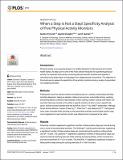When a step is not a step! Specificity analysis of five physical activity monitors

Date
2017-01-13Author
O’Connell, Sandra
Ó Laighin, Gearóid
Quinlan, Leo R.
Metadata
Show full item recordUsage
This item's downloads: 419 (view details)
Cited 16 times in Scopus (view citations)
Recommended Citation
O’Connell, Sandra, ÓLaighin, Gearóid, & Quinlan, Leo R. (2017). When a Step Is Not a Step! Specificity Analysis of Five Physical Activity Monitors. PLOS ONE, 12(1), e0169616. doi: 10.1371/journal.pone.0169616
Published Version
Abstract
IntroductionPhysical activity is an essential aspect of a healthy lifestyle for both physical and mental health states. As step count is one of the most utilized measures for quantifying physical activity it is important that activity-monitoring devices be both sensitive and specific in recording actual steps taken and disregard non-stepping body movements. The objective of this study was to assess the specificity of five activity monitors during a variety of prescribed non-stepping activities.MethodsParticipants wore five activity monitors simultaneously for a variety of prescribed activities including deskwork, taking an elevator, taking a bus journey, automobile driving, washing and drying dishes; functional reaching task; indoor cycling; outdoor cycling; and indoor rowing. Each task was carried out for either a specific duration of time or over a specific distance. Activity monitors tested were the ActivPAL micro (TM), NL-2000 (TM) pedometer, Withings Smart Activity Monitor Tracker (Pulse O-2)(TM), Fitbit One (TM) and Jawbone UP (TM). Participants were video-recorded while carrying out the prescribed activities and the false positive step count registered on each activity monitor was obtained and compared to the video.ResultsAll activity monitors registered a significant number of false positive steps per minute during one or more of the prescribed activities. The Withings (TM) activity performed best, registering a significant number of false positive steps per minute during the outdoor cycling activity only (P = 0.025). The Jawbone (TM) registered a significant number of false positive steps during the functional reaching task and while washing and drying dishes, which involved arm and hand movement (P

